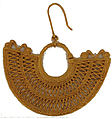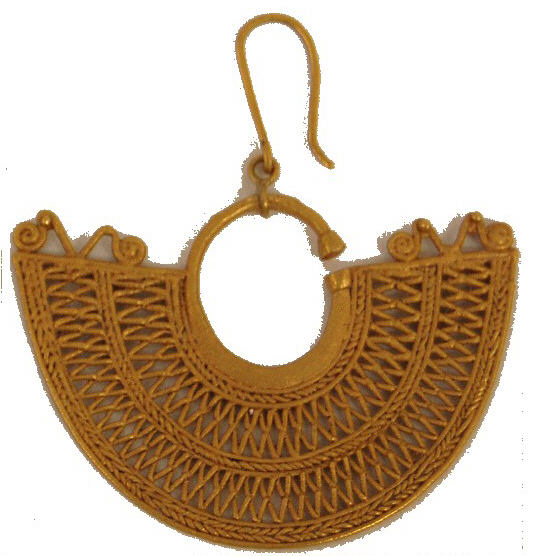Pair of Ear Ornaments
Not on view
This pair of ear ornaments is an example of one of the hallmark forms of the metalwork produced by the Zenú people who lived and currently live in the Caribbean Lowlands of Colombia. The ornaments have a cast filigree design. In other words, they have the appearance of wirework but, instead of actually shaping metal wire into the form, the artists created the wire design by casting it, in this case, through the lost wax process (please see below for further detail). Each ornament was cast as one piece, except for the wire attachments on each, which were added recently. While these ornaments are examples of cast filigree, in recent centuries, people in Mompox, in the Zenú region, have been practicing filigree, using wire rather than casting metal. Today, they work typically in silver, and people’s memories point to early Zenú and Spanish Colonial-period metalworking traditions as origins of their practice (Lobo 2014).
Both ear ornaments in the present example consist of a loop of metal at the top center that forms an incomplete ring, with a narrow space between two pronounced ends. This opening would have allowed a person to attach the ornament to their body, likely pushing the top pronounced end into their pierced ear. The bottom half of this central loop connects with a semi-circular, flat piece of metal that contains five registers of design: three rows of braided design that alternate with two more open areas of looped-and-twisted threads of metal. Each register of braided design is outlined, above and below, by a thin band of metal.
Near the top of the ornament, there is a linear motif in the shape of the letter "m" whose two ends turn into spirals. In all cases, except two on ornament "a," the top vertices of this letter "m" motif show slight circular projections of metal. These motifs appear to the left and right of the central loop on each ornament. They actually may be abstract depictions of fauna (please see below).
There is a wire attached to the central loop of each ornament that was most likely added after the ornaments’ excavation. This attachment consists of a loop through which the ornament’s central loop passes, another loop through which a wire extension passes, and the wire extension that curves around and whose end could have been threaded through someone’s ear. The obverse and reverse of each ornament are fairly identical, except for the orientation of the central loop opening, which will be on the left or right depending on the face someone is viewing or the face that the person wearing the ornaments chose to display.
In lost-wax casting, artists create a solid wax model of the object they intend to produce. Every element that is designed in wax will be eventually reproduced in metal. Artists are not solely confined to wax; other organic materials, like resin, easily capable of melting out or decomposing, can be used to form the model. In some cases, the wax model is built around a core, often of ceramic, especially if the intended object is hollow or has an internal cavity.
Artists then design a system for the molten metal to successfully flow into the space occupied by the wax model. They make a wax "sprue" at the point where molten metal will be introduced, "gates" at different locations around the casting, and "runners" as long channels for the metal to reach other locations. "Risers" may be added to ensure that molten metal adequately fills certain spaces, as the metal will shrink on solidification and otherwise produce voids.
Once this wax structure is fully created, artists make a mold of the object around the wax. The mold is typically a refractory material—that is, capable of sustaining high temperatures—and usually consists of ceramic, built up from the surface of the wax model as "investment." Artists apply the ceramic as a slurry in layers, allowing it to dry and harden.
The entire structure is then heated, melting out the wax through the added "tree" of channels, also referred to as the "gating system." The mold, in effect, has been pre-heated, which allows for a less drastic temperature gradient at the mold-metal interface, encourages growth of metal grains, and permits slower cooling of the molten metal. The artists then pour molten metal, often from a crucible, into the mold, using the sprue as the entry point. Once the metal solidifies, the artists need to break open the hardened mold to release the cast metal object. They may finish the metal by cutting off elements of the "tree," removing remnants of the mold and of the core, if one was used and maintained throughout the casting process, and polishing the metal surface. The entire process, depending on the size of the object, can be labor- and time-intensive and requires collaboration of several people.
In the direct lost-wax casting technique, artists build the wax model from scratch. In the indirect version, they create molds of a pre-existing model, and use these molds to form the wax model, so that they can produce metal objects that are more or less identical, as the molds are reusable.
The use of lost-wax casting in the past has been identified through archaeological remains (see Bray 1971 for examples for Colombia and elsewhere), and scholars often cite the process undertaken by Mexica metalworkers as described by Spanish Friar Bernardino de Sahagún and Nahua authors (1959, Book IX, Ch. 16; 1961, Book X, Ch. 7) in the Florentine Codex, produced in A.D. 1575-1577. The interpretation of lost-wax casting and the vocabulary used to describe it also have been influenced by small-scale and industrial lost-wax casting as practiced by foundries around the world in recent years.
On these two ear ornaments, it is clear that the artists used thin threads of wax to create a model that, when cast in metal, would ultimately give the appearance of filigree.
The three registers that show a braided design were made by plaiting threads of wax. In the case of the top and middle registers, the artists plaited two threads of wax, while in the bottom registers, they plaited four. The artists created the two larger registers of open work by looping and twisting threads of wax, creating tens of these looped-and-twisted threads to form two rows in each register, and joining the threads and the rows likely with a careful application of heat or pressure. The design of these alternating registers of open work is seen in other Zenú ear ornaments at the Metropolitan, including 1974.271.58, 1974.271.59, and 2005.409.1a, b. In the last of these three examples, the looped-and-twisted threads have more dimensionality than those seen in the present ornament.
These objects would not have required the use of a core, as they are relatively flat. It is possible that artists created a mold of this ornament to start, and then created two wax models, which would be ultimately cast as the two present ornaments. There are slight differences in the metal objects, and they are small enough that they could have arisen in creating two wax models from the same mold. The differences are seen especially at the extreme ends of the larger open work registers, just below the spiral motifs, where there are partial or compressed looped-and-twisted threads. Comparing the two ornaments, the spacing and orientation of these threads are clearly different.
The ornaments show a black coloration in some areas, which likely relates to copper-related corrosion. They also retain pieces of the mold material, especially in the crevices of the looped-and-twisted design. Some areas show a surface that is dendritic, that is, a tree-like appearance of coarse metal grains. This feature results from the slow cooling of the metal that took place if the mold was pre-heated. Overall, the ornaments appear to have been highly polished after their excavation.
The objects are an example of Type 2 within the corpus of Zenú cast filigree ear ornaments following the classification system of Ana María Falchetti. Metropolitan Museum of Art 1974.271.58 and 1974.271.59 are similar examples. Type 2 is known as "fine, cast filigree, semi-circular ear ornaments" or "orejeras semi-circulares de filigrana fundida fina," as defined by Falchetti (1995, 60). These two ornaments are most similar to one illustrated by Falchetti (1995, fig. 17b), who interprets the motifs that appear near the tops of the ornaments to be abstracted representations of animals, possibly birds or snakes. The small circular projection in the "m" may suggest an eye of the animal and on each side, the artists may be illustrating two birds facing each other. It is possible that the artists chose to depict one aspect of the multi-layered universe that Zenú people today in San Andrés de Sotavento envision: humans occupy the middle layer, while above and below, there are particular spirits related to animals (Turbay and Jaramillo 1998). Birds, which may be shown here, are considered to move between different layers (Falchetti 2000, 138); in this case, do they occupy one layer above the open work, which constitutes a layer below? In any case, an invitation to Zenú communities and metalworkers today to interpret these scenes would be an important step forward.
Objects of this type have been recovered from a wide range of locations in the Zenú archaeological region. Thus, the designation of "Caribbean Lowlands" is used to describe their archaeological provenance. While these ornaments have relatively high gold content, there are objects of this type that are gold-copper alloys with high copper content and were produced in the Serranía de San Jacinto. Other ornaments that are part of Falchetti’s Type 2 are reportedly from a single funerary context near Ayapel, between the San Jorge and Cauca Rivers, and include objects with a greater number of alternating registers of braided designs and looped-and-twisted threads (see University of Pennsylvania Museum of Anthropology and Archaeology, Philadelphia, PA SA2732, SA2733, and SA2734).
For further information on the context of Zenú metalwork, please see Metropolitan Museum of Art 2005.409.1a,b.
Bryan Cockrell, Curatorial Fellow, Arts of Africa, Oceania, and the Americas, 2017
Related objects: 1974.271.58, 1974.271.59, 2005.409.1a, b
Further reading
Bray, Warwick. "Ancient American Metal-Smiths." Proceedings of the Royal Anthropological Institute of Great Britain and Ireland (1971): 25-43.
Falchetti, Ana María. El oro del Gran Zenú. Bogotá: Banco de la República, 1995.
———. "The Gold of Greater Zenú: Prehispanic Metallurgy in the Caribbean Lowlands of Colombia." In Precolumbian Gold: Technology, Style and Iconography, edited by Colin McEwan. London: British Museum Press, 2000.
Lobo, Jimena. "Changing Perspectives: The Archives of Memory and Material Culture." Archaeological Review from Cambridge 29, no. 2 (2014): 69-87.
Sahagún, Bernardino de. Florentine Codex: General History of the Things of New Spain. Edited and translated by Arthur J.O. Anderson and Charles E. Dibble. Monographs of the School of American Research. 13 vols. Santa Fe: School of American Research; Salt Lake City: University of Utah Press, [1575-77], 1950-82.
Turbay, Sandra and Susana Jaramillo. "Los indígenas Zenúes." In Geografía humana de Colombia: Región Andina Central IV, 3. Bogotá: Instituto Colombiano de Cultura Hispánica, 1998.
Due to rights restrictions, this image cannot be enlarged, viewed at full screen, or downloaded.
This artwork is meant to be viewed from right to left. Scroll left to view more.



